The next-gen MacBook Pro with Retina Display Review
by Anand Lal Shimpi on June 23, 2012 4:14 AM EST- Posted in
- Mac
- Apple
- MacBook Pro
- Laptops
- Notebooks
Last year when I wrote about the new MacBook Airs I offered two forward looking paragraphs:
What happens from here on out is what's really interesting. Intel has already committed to moving the TDP of its mainstream parts from 35W - 45W down to 10 - 20W. Since the Air is the new mainstream Mac notebook, Apple has already made that move. The performance in this 10 - 20W segment is going to get much better over the next two years, particularly once Haswell arrives.
The Thunderbolt Display is the first sign of what's to come. Moving IO controllers and expansion into the display, and potentially even moving discrete GPUs out of the notebook are all in store for us. Apple is really ahead of the curve here, but it's easy to imagine a future where laptops become a lot more like the new Air and shift to a couple high bandwidth ports instead of numerous lower bandwidth connections.
Perhaps I was being too aggressive in the prediction of a couple of high bandwidth ports. After all, the next-generation MacBook Pro with Retina Display features four such IO ports (2 x Thunderbolt and 2 x USB 3.0). But you get my point. Gigabit Ethernet and Firewire 800 are both gone. The discrete GPU is still present but I suspect even its days are numbered, at least inside the chassis. The personal computer as we knew it for so long, is changing.
The personal computer is getting thinner, lighter, more integrated and more appliance-like. The movement is no longer confined to just Apple either. The traditional PC OEMs are following suit. Even Microsoft has finally entered the PC hardware business, something it threatened to do for years but hadn't until now. Distribution models will change, the lines between different form factors will continue to blur. What was once a mature industry is going through a significant transformation. It’s exciting but at the same time it makes me uneasy. When I first got into this industry everyone had stories of companies with great ideas that just didn’t make it. As we go through this revolution in computing I’m beginning to see, first hand, the very same.
Apple makes the bulk of its revenue from devices that don’t look like traditional personal computers. For the past couple of years I’ve been worried that it would wake up and decide the traditional Mac is a burden, and it should instead be in the business of strictly selling consumer devices. With its announcements two weeks ago in San Francisco, I can happily say that my fears haven’t come true. At least not yet.
It’s been a while since Apple did a really exciting MacBook Pro launch. Much to my surprise, even the move to Sandy Bridge, the first quad-core in a MacBook Pro, was done without even whispers of a press conference. Apple threw up the new products on its online store, shipped inventory to its retail outlets, updated the website and called it a day. Every iPhone and iPad announcement however was accompanied with much fanfare. The MacBook Pro seemed almost forgotten.
With its WWDC unveil however Apple took something that it had resigned to unexciting, dare I say uncool status, and made a huge deal about it. Two weeks ago Apple did the expected and offered relatively modest upgrades to all of its portable Macs, all while introducing something bold.
Apple calls it the MacBook Pro with Retina Display. You’ll see me refer to it as the next-gen MacBook Pro, Retina MacBook Pro, rMBP or some other permutation of these words.
After using it for the past two weeks I can honestly say it’s the best Mac Apple has ever built. And there’s a lot more to it than hardware.
Portability
If you were hoping for a 15-inch MacBook Air, that’s not what the rMBP is. Instead it is a far more portable 15-inch MacBook Pro. I have to admit I was a bit let down the first time I laid eyes on the next-gen MacBook Pro, it looks good but it doesn’t look all that different. The disappointment quickly faded as I actually picked up the machine and started carrying it around. It’s not ultra light, but man does it make the previous chassis feel dated.
While I never really liked lugging around the old MBP (and it always made me feel like the old fogey at tradeshows where everyone else had something 13-inches or smaller), carrying the rMBP is a pleasure by comparison. Pictures really don’t do it justice. The impressively thin display assembly or overall chassis thickness look neat in a photo but it’s not until you actually live with the rMBP that you can appreciate what Apple has done here. I carry around a 15-inch MacBook Pro because it’s my desktop, and as such it’s incredibly useful to have with me when I travel. For my personal usage model, the Retina MacBook Pro is perfect.
If your workload demands that you need the performance of a MacBook Pro and your lifestyle requires you to carry it around a lot, the reduction in thickness and weight alone will be worth the upgrade to the rMBP. If you spend most of your time stationary however, you’ll have to be sold on the display and internal characteristics alone. The bad news is if the design doesn’t get you, everything else will.

From left to right: 11-inch MacBook Air, 13-inch MacBook Air, 15-inch MacBook Pro, MacBook Pro with Retina Display
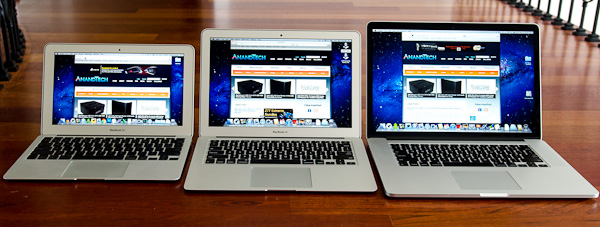
From left to right: 11-inch MacBook Air, 13-inch MacBook Air, MacBook Pro with Retina Display
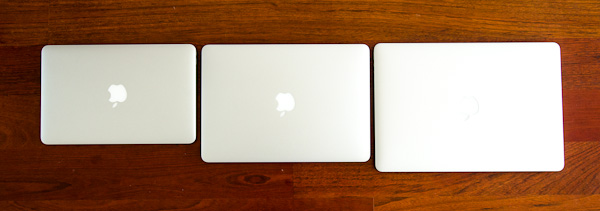
From left to right: 11-inch MacBook Air, 13-inch MacBook Air, MacBook Pro with Retina Display


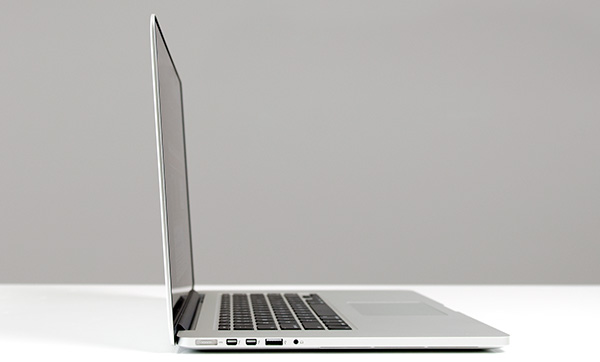
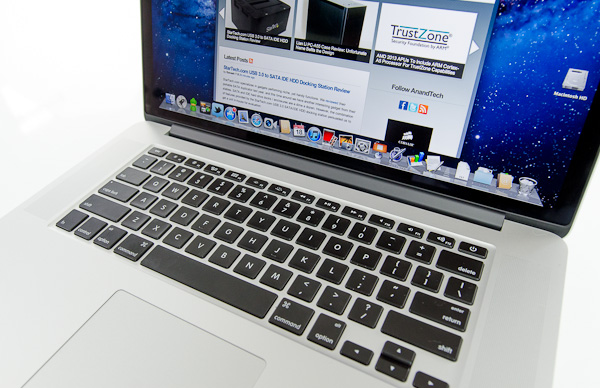
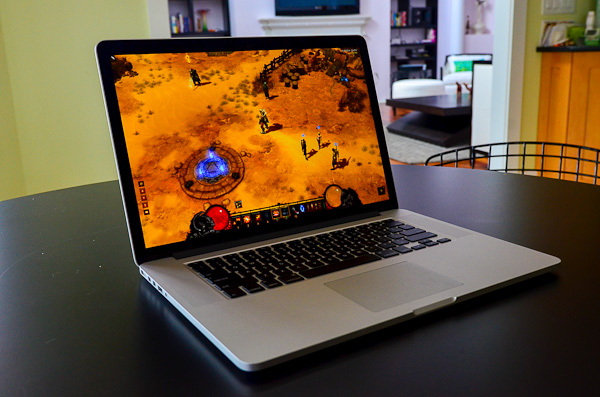
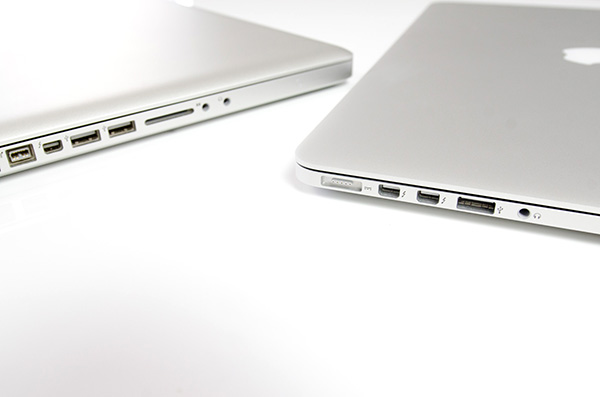
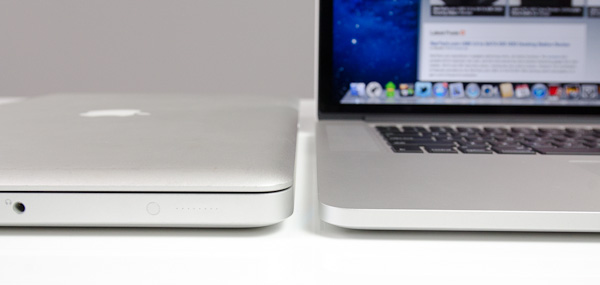








471 Comments
View All Comments
nikolayo - Saturday, June 23, 2012 - link
How come that the part "Vastly Improved Thermals" comes with no data about surface temperatures?ringgix - Saturday, June 23, 2012 - link
dont forget he also doesnt supply any data for the improved noisejjjjj - Saturday, June 23, 2012 - link
From the screenshots I've seen, also in this review, it seems like text from applications that don't support the retina display is using subpixel antialiasing. You can see this by zooming in on the pixels: if there is any non-gray colored pixels in black text on white background, subpixel antialiasing is used. Subpixel antialiasing makes no sense when the pixels of the rendered fonts are doubled; the subpixels of a 2x2 "retina pixel" are not laid out in the way that is assumed for the subpixel antialiasing to work in an optimal way.It would be interesting if someone with an rMBP could comment on the perceived quality of pixel doubled text (1440x900 setting) with and without subpixel antialiasing turned on. You can set this in the System Preferences, under the General tab, by toggling the setting "Use LCD font smoothing when available". Changing this setting will of course also influence text in applications that do support the retina display, but the difference would be much smaller, and in this case you would of course expect subpixel antialiasing to produce better-looking text, as the assumptions required for subpixel antialiasing to work are valid.
jjjjj - Saturday, June 23, 2012 - link
It seems like three external screens are actually supported for the rMBP, http://support.apple.com/kb/HT5219#dispnum . "MacBook Pro (Retina, Mid 2012) can support an HDMI-compatible device on its HDMI port while also using two Thunderbolt displays."crazysurfanz - Saturday, June 23, 2012 - link
Thanks Anand for an excellent review as always. Just another reason why I keep coming back to Anandtech.Couple of typo's on the GPU Performance page... you've referred to the 6750M (that's what's in the graphs at least) as a 6570M a couple of times (I'm not really that familiar with Mac hardware so not sure which is actually right):
One question I had was around running Windows on these - do you have to run the 'bootcamp' drivers - or can you just install the normal Windows NVIDIA drivers for the GT650M?
With regards to the the lack of dynamic graphics switching / Optimus (in the article you state that only the dGPU is exposed to windows). I take it that it's not quite as simple as installing the normal nvidia drivers and the Intel HD4000 drivers - though I'm not sure what the missing link is here, since there are certainly other Windows laptops with IVB and GT650M that run Optimus - I guess what I'm trying to figure out is - why does the fact that this hardware (IVB/GT650M) happens to be in a Mac mean that Optimus/dynamic graphics switching is unavailable?
crazysurfanz - Saturday, June 23, 2012 - link
One other thing, what's the backdrop in these pictures... love the colours... and a high res wallpaper (2880x1800?) of that backdrop would be awesome:http://images.anandtech.com/reviews/mac/retinaMacB...
http://images.anandtech.com/reviews/mac/retinaMacB...
http://images.anandtech.com/reviews/mac/retinaMacB...
Also love the camels:
http://images.anandtech.com/reviews/mac/retinaMacB...
Ryan Smith - Saturday, June 23, 2012 - link
The current Windows NVIDIA drivers do not work (it's likely just a matter of device IDs), so you need the drivers Apple includes with BootCamp.crazysurfanz - Saturday, June 23, 2012 - link
So if/when those drivers work - will that then enable Optimus/dynamics graphics switching? Or is there more to the puzzle?chrisledet - Saturday, June 23, 2012 - link
Awesome review Anand.Megatran - Saturday, June 23, 2012 - link
I don't think you can conclude or suggest that there are "vastly" improved thermals without even using a tool that measures temperatures in comparison to a baseline. That entire page talks more about noise characteristics than "thermal" performance.